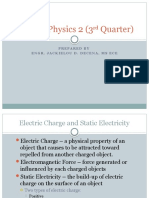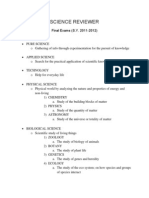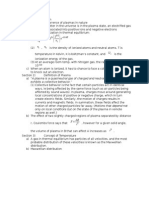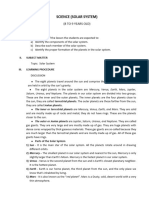General Physics Reviewer
Uploaded by
Xyrell Claude MontaGeneral Physics Reviewer
Uploaded by
Xyrell Claude MontaPHY10 : REVIEWER
Page : 1
Units Of Measurements
Basic Conversion Factors
A. LENGTH
Metric
1 m = 1000 mm
1 m = 100 cm
1 km = 1000 m
Non-Metric
1 m = 1.0936 yards
1 m = 39.37 inches
1 cm = 0.3937 inch
B. MASS
Metric
1 kg = 1000 g
1 g = 1000 mg
1 tonne (metric ton) = 1000 kg
Non-Metric
1 slug = 14.5939 kg
1 slug = 32.17405 pound-mass
1 pound-mass = 0.4536 kg
1 ton (US) or short ton = 907.185 kg
1 ton (UK) or long ton = 1,016.047 kg
C. TIME
Metric
1 sec = 109 nanoseconds (ns)
1 sec = 106 microseconds (s)
1 sec = 103 milliseconds (ms)
1 sec = 102 centiseconds (cs)
Non-Metric
1 minute = 60 sec
1 hour = 3,600 sec
1 day = 86,400 sec
1 Julian Year = 31,557,600 sec = 365.25 days
D. FORCE
Metric
1 Newton (N) = 105 dynes
Non-Metric
1 pound-force = 4.448 Newtons
FOR REVIEW PURPOSES ONLY : KEEP AWAY DURING YOUR FINAL EXAMINATION
PHY10 : REVIEWER
Page : 2
A. Vectors
Scalar Quantity - a quantity which only magnitude but no direction
Ex. Speed 40 kph
Vector Quantity - a quantity which has both magnitude and direction
Ex. Velocity- 40 kph due north
A.1 Analytical Methods of Finding the Resultant
A. Triangle Method construct a triangle using the 2 given vectors and use concepts of
trigonometry such as Cosine Law, Sine Law or Pythagorean Theorem to solve for the unknown
vector.
B. Vector Resolution Method or Component Method- it is the process of resolving the vector to its
vertical and horizontal components
FOR REVIEW PURPOSES ONLY : KEEP AWAY DURING YOUR FINAL EXAMINATION
PHY10 : REVIEWER
Page : 3
A.2 Vector Multiplication
1. Dot Product or Scalar Product
2. Cross Product or Vector Product
B. Kinematics
It is the study of how object moves without regard to the cause of motion.
B.1 Calculus Based (Time dependent)
Let :
Position (x) be a time dependent quantity : thus x(t)
Velocity (v) is the first derivative : v(t) = dx/dt
Acceleration (a) is the next derivative : a(t) = dv/dt = dx/d2t
It is therefore possible to reverse this order :
Acceleration (a) be a time dependent quantity : thus a(t)
Velocity (v) is the first integral : v(t) = a(t)dt
Position (x) is the next integral : x(t) = v(t)dt = a(t)d2t
Instantaneous Values are obtained by substituting the exact value of time (t) in the equations above
Average velocity and acceleration values:
vave = [xF xO] /(tF tO)
aave = [vF vO] /(tF tO)
where :
where :
xO = x(tO) and xF = x(tF)
vO = v(tO) and vF = v(tF)
FOR REVIEW PURPOSES ONLY : KEEP AWAY DURING YOUR FINAL EXAMINATION
PHY10 : REVIEWER
Page : 4
B.2 Motions with constant acceleration
EQUATIONS for motion along a straight path (x-axis)
VF = VO + at
s = VOt + at2
VF2 = VO2 + 2as
Note : if a = 0 ; V = constant
EQUATIONS for motion along vertical axis (y-axis)
VF = VO + gt
h = VOt + gt2
VF2 = VO2 + 2gh
Note : if object is free-fall or dropped VO = 0
EQUATIONS for Projectile Motion (x-axis)
VOX = VO cos : VOX Horizontal Component of VO
VOX = VFX = VnX Note : Constant Horizontal Velocities
s = Vx t
Other Important Equations
R = [VO 2 sin (2)] /g
tR = R/VOX = 2tH
Where:
VF final velocity
VO initial velocity
s horizontal displacement/distance traveled
a constant acceleration
h vertical displacement/ height
g gravitational acceleration = 9.8 m/s2
Sign Convention (from origin) : s : (+) & h :
(+)
V : (+) OR (+)
a : (+) if speeding up OR (+) , hence g = 9.8
m/s2
EQUATIONS for Projectile Motion (y-axis)
VOY = VO sin
: VOY Vertical Component of VO
VFY = VOY + gt
Note : See sign conventions below
h = VOYt + gt2
VFY2 = VOY2 + 2gh
g = 9.8 m/s2
Note g = + 9.8 m/s2
H = VOY2/(2g) = (VO sin )2/(2g)
tH = VOY /g = (VO sin )/g =( tR/2)
Sign Convention :
Within Area A : (+) h and (+) VYs
Note :
Within Area B : (+) h and () VYs
1.
Within Area C : () h and () VYs
2.
VYs are the vertical velocity
component values
Common level vertical velocity
components have the same
magnitude but opposite in
direction
FOR REVIEW PURPOSES ONLY : KEEP AWAY DURING YOUR FINAL EXAMINATION
PHY10 : REVIEWER
Page : 5
C. Forces & Laws of Motion
C.1 Newtons Laws of Motion
Newtons First Law of Motion
An object sitting at rest will remain at rest if the sum of all forces acting on the object is zero.
Similarly, if an object is moving and the sum of the forces acting on the object is zero, then the
object will continue to move in the same direction with same speed. [F = 0]
First Condition of Equilibrium
The body or system at this condition remains at rest or moves in a straight line with constant
velocity. (Translational Equilibrium)
Static Equilibrium refers to all objects at rest.
Dynamic Equilibrium refers to all objects / systems moving at constant velocity
F = R = 0
[FX=0 & FY = 0]
Newtons Second Law of Motion (NSLM)
If an unbalanced force acts on a body, it is accelerated by an amount proportional to the
unbalanced force and in the same direction but inversely to its mass. [a = Fnet / m] or [Fnet = ma]
F =ma where :
FX= maX & FY = 0 (if motion is relatively or purely horizontal)
FX= 0 & FY = maY (if motion is relatively or purely vertical)
Newtons Third Law of Motion
Whenever one object exerts a force on a second object, the second object exerts a reaction force
of equal magnitude but opposite direction on the first object. It indicates that forces come in pairs an
action force and reaction force
C.2 Contact Forces
Friction Force (f) force acting between the body and its surface of contact which is acting parallel but
opposite to the direction of motion
Normal Force (N) surface reaction force due to the weight of the body. It is always perpendicular to
the surface of contact .
FOR REVIEW PURPOSES ONLY : KEEP AWAY DURING YOUR FINAL EXAMINATION
PHY10 : REVIEWER
Page : 6
C.3. NSLM Equations for acceleration
3.a. Sliding Objects
a = g (sin cos)
3.b. Atwoods Machine 1: (No contact surface)
if : m1 > m2
a = g (m1 m2)/(m1 + m2)
; going to the side of m1
T = m1(g a) or T = m2(g + a)
if : m2 > m1
a = g (m2 m1)/(m1 + m2) ; going to the side of m2
T = m2(g a) or T = m1(g + a)
3.c Atwoods Machine 2: (With contact surface)
Motion of the system is dependent mainly on these three things:
1. Mass of each object
2. Angle of the inclined surface
3. Surface friction
The equations here assumes that either the angle of inclined or the
surface friction does NOT PREVENT motion(it means that the value
of acceleration you get here are always positive)
Going to the side of m1
a = g (m1sin m1cos m2)/(m1 + m2)
T = m2(g + a)
Going to the side of m2
a = g (m2 m1cos m1sin)/(m1 + m2) ; T = m2(g a)
if = 0
Logically it goes to the side of m2
a = g (m2 m1)/(m1 + m2)
T = m2(g a)
FOR REVIEW PURPOSES ONLY : KEEP AWAY DURING YOUR FINAL EXAMINATION
PHY10 : REVIEWER
Page : 7
D. Circular Motion
Centripetal Force (FC)
The net force that causes object to move in a
circular path rather than a straight one.
Centripetal means towards the center, so this
goes towards the axis of rotation.
Centripetal Acceleration (aC)
The acceleration associated with the centripetal
force. It also goes towards the center of rotation.
Also known as the radial acceleration
EQUATIONS
FC = maC
FC = mv2/R
FC = mR2
FC = 4mR2/T2
FC = 4mR2f2
Where:
2
aC = v /R
v = R
= 2/T
T = 1/f
v linear or tangential velocity (m/s)
angular velocity (rad/s)
T period of rotation, time for 1 complete revolution (seconds)
f frequency, number of revolutions at a given time (per second or hertz)
Newtons Second Law of Motion Applications
1. Horizontal Circle : FX= maC & FY = 0
Where:
1.1 Flat Curve
vMAX = S Rg
v linear or tangential velocity (m/s)
vMAX maximum velocity
S static coefficient of the road surface
1.2 Banked Curve
2
R radius of curvature (m)
tan = v /(Rg)
1
2
banking angle ()
= tan [v /(Rg)]
2. Vertical Circle (Non Uniform) : FX= 0 & FY = maC
@ Lowest Point
@ Highest Point
aCmax = vMAX2/R
aCmin = vMIN2/R
FC is maximum
FC is minimum
FOR REVIEW PURPOSES ONLY : KEEP AWAY DURING YOUR FINAL EXAMINATION
PHY10 : REVIEWER
Page : 8
E. Newtons Law of Gravitation
-Every particle of matter in the universe attracts every other particle with a force that is directly
proportional to the product of the masses of the particles and inversely proportional to the square of
the distance between them.
F = Gm1m2 / (R2)
Where:
m1 & m2 masses of the two particles (kg)
R distance between the two particles (m)
F force of attraction (N)
G gravitational constant = 6.67 x10-11 N m2 /kg2
E.1 Determining the Acceleration Due to Gravity, g
1. Consider an object of mass m falling near a planets surface, the force of attraction is the
gravitational pull of the planet toward the object is the weight of the object on that planet.
F=W
G m MPlanet/ R2 = mg
g = G MPlanet/ R2
2. Using the size comparison between the planets mass and radius to that of earths
gX = gE(MX/ME)(RE/RX)2
E.2 Satellite Motion (Constant Radius Orbit)
In order to determine orbital period and orbital (radial) distances of satellites (both natural and
artificial), the Gravitational force is equated to the Centripetal force.
FG = FC
GM1M2/R2 = M2aC
(M2 is the orbiting object)
2
GM1/R = aC
GM1/R2 = 42R/T2
Cross multiply to simplify:
GM1T2 = 42R3
(From here you can derive most of the needed equations)
Where : mass of center planet (M1), radial distance (R) & orbital period (T)
Since : G = 6.67x10-11 Nm2/kg2 and 42 = 39.4784, we can have this as a constant
M1T2/ R3 = 42/G = 5.9188x1011 kg2/Nm2
(M1T2)/R3 = 5.9188x1011 kg-s2/m3
FOR REVIEW PURPOSES ONLY : KEEP AWAY DURING YOUR FINAL EXAMINATION
You might also like
- Biology Reviewer Grade 12 STEM First Semester100% (5)Biology Reviewer Grade 12 STEM First Semester8 pages
- GENERAL CHEMISTRY 2 Midterms Reviewer RevisedNo ratings yetGENERAL CHEMISTRY 2 Midterms Reviewer Revised4 pages
- Physics Entrance Exam Review Questions A PDF88% (8)Physics Entrance Exam Review Questions A PDF9 pages
- Factors Affecting The Relative Rates of Electrophilic Aromatic Substitution Reactions100% (2)Factors Affecting The Relative Rates of Electrophilic Aromatic Substitution Reactions5 pages
- Genphysics 1ST Periodical Test For PrintingNo ratings yetGenphysics 1ST Periodical Test For Printing5 pages
- Direction: Choose The Best Answer. Write The Letter Only.: General Physics 2 Long Quiz 1 DATENo ratings yetDirection: Choose The Best Answer. Write The Letter Only.: General Physics 2 Long Quiz 1 DATE11 pages
- General Physics 2 (3 Quarter) : Prepared by Engr. Jackielou D. Decena, Ms Ece100% (1)General Physics 2 (3 Quarter) : Prepared by Engr. Jackielou D. Decena, Ms Ece55 pages
- Grade 11 STEM 4th Quarter Reviewer Basic Calculus100% (1)Grade 11 STEM 4th Quarter Reviewer Basic Calculus3 pages
- Bio136-2 - Fundamentals of Microbiology and Immunology: Problem Set Topic 2No ratings yetBio136-2 - Fundamentals of Microbiology and Immunology: Problem Set Topic 25 pages
- Factors Affecting Relative Rates of Nucleophilic Substitution ReactionsNo ratings yetFactors Affecting Relative Rates of Nucleophilic Substitution Reactions5 pages
- Introduction To Plasma Physics and Controlled Fusion Notes For Journal 1100% (1)Introduction To Plasma Physics and Controlled Fusion Notes For Journal 118 pages
- STS Module 3A The Scientific Revolution (ACQUIRE)No ratings yetSTS Module 3A The Scientific Revolution (ACQUIRE)3 pages
- Singularity Playtime: at Eternity's GateNo ratings yetSingularity Playtime: at Eternity's Gate38 pages
- 2.2 Lubrication Approximation For Flow in A Thin LayerNo ratings yet2.2 Lubrication Approximation For Flow in A Thin Layer3 pages
- Modification of The Gurson Model For Shear Failure: K. Nahshon, J.W. HutchinsonNo ratings yetModification of The Gurson Model For Shear Failure: K. Nahshon, J.W. Hutchinson17 pages
- The Adventure of The Sussex Vampire - Arthur Conan DoyleNo ratings yetThe Adventure of The Sussex Vampire - Arthur Conan Doyle10 pages
- (Studies in The History of Philosophy of Mind 10) Håvard Løkke (Auth.) - Knowledge and Virtue in Early Stoicism-Springer Netherlands (2015) PDF100% (1)(Studies in The History of Philosophy of Mind 10) Håvard Løkke (Auth.) - Knowledge and Virtue in Early Stoicism-Springer Netherlands (2015) PDF143 pages
- Chapter 3 The Methodology of Economic Research: AidankaneNo ratings yetChapter 3 The Methodology of Economic Research: Aidankane5 pages
- Winter Guide To The Constellations: What Is A Star?No ratings yetWinter Guide To The Constellations: What Is A Star?18 pages
- Factors Affecting The Relative Rates of Electrophilic Aromatic Substitution ReactionsFactors Affecting The Relative Rates of Electrophilic Aromatic Substitution Reactions
- Direction: Choose The Best Answer. Write The Letter Only.: General Physics 2 Long Quiz 1 DATEDirection: Choose The Best Answer. Write The Letter Only.: General Physics 2 Long Quiz 1 DATE
- General Physics 2 (3 Quarter) : Prepared by Engr. Jackielou D. Decena, Ms EceGeneral Physics 2 (3 Quarter) : Prepared by Engr. Jackielou D. Decena, Ms Ece
- Bio136-2 - Fundamentals of Microbiology and Immunology: Problem Set Topic 2Bio136-2 - Fundamentals of Microbiology and Immunology: Problem Set Topic 2
- Factors Affecting Relative Rates of Nucleophilic Substitution ReactionsFactors Affecting Relative Rates of Nucleophilic Substitution Reactions
- Introduction To Plasma Physics and Controlled Fusion Notes For Journal 1Introduction To Plasma Physics and Controlled Fusion Notes For Journal 1
- 2.2 Lubrication Approximation For Flow in A Thin Layer2.2 Lubrication Approximation For Flow in A Thin Layer
- Modification of The Gurson Model For Shear Failure: K. Nahshon, J.W. HutchinsonModification of The Gurson Model For Shear Failure: K. Nahshon, J.W. Hutchinson
- The Adventure of The Sussex Vampire - Arthur Conan DoyleThe Adventure of The Sussex Vampire - Arthur Conan Doyle
- (Studies in The History of Philosophy of Mind 10) Håvard Løkke (Auth.) - Knowledge and Virtue in Early Stoicism-Springer Netherlands (2015) PDF(Studies in The History of Philosophy of Mind 10) Håvard Løkke (Auth.) - Knowledge and Virtue in Early Stoicism-Springer Netherlands (2015) PDF
- Chapter 3 The Methodology of Economic Research: AidankaneChapter 3 The Methodology of Economic Research: Aidankane
- Winter Guide To The Constellations: What Is A Star?Winter Guide To The Constellations: What Is A Star?































































































